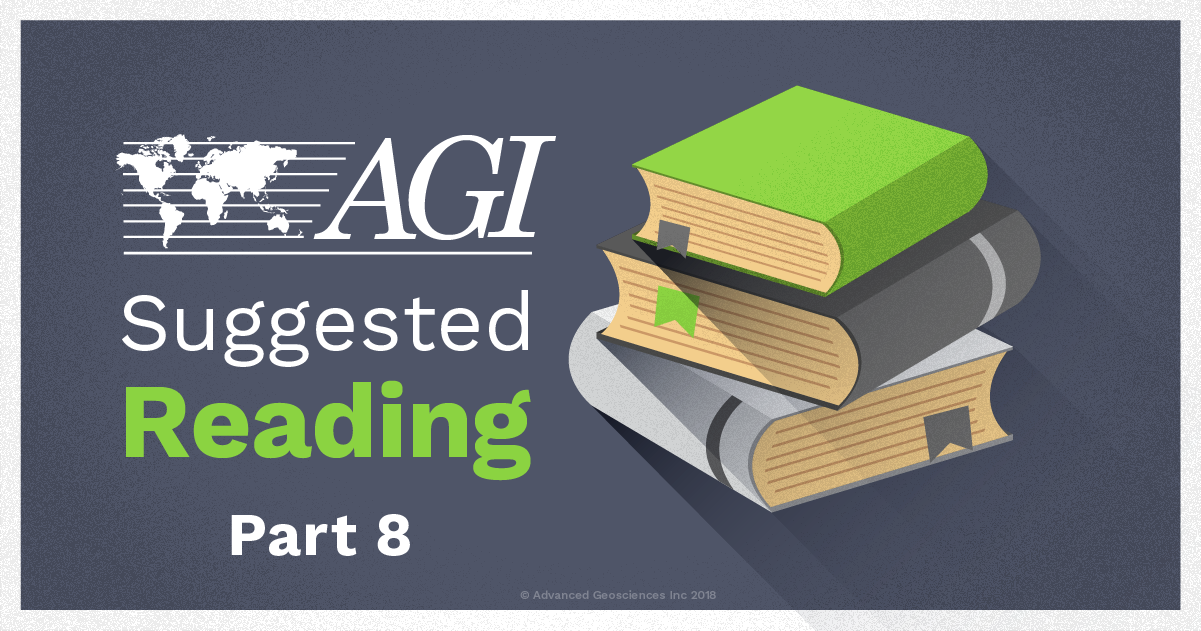
We’re finally at the end of this eight-part series. We would like to say “we’ve saved the best suggestions for last”, but all of our suggestions are pretty fantastic reads if you want to learn more about resistivity, induced polarization, and more. Maybe its because we're posting this around the holiday season, or maybe its because we're sad to see the series end, but we've included 4 entries this time around instead of 3.
As we’ve mentioned in previous posts, let us know if you have suggestions for further reading. It doesn’t even have to be about the topics we’ve shared. For instance, we would love some suggestions for books on engineering or hydrology! Just let us know on Facebook, Twitter, or LinkedIn.
And in case you’ve missed it, here are all of our previous suggestions in this series:
We may revisit this series in the future with more suggestions. For now, we think that the picks in this series will be a great starting point. And with that said, we can jump into our final reading suggestions.
Ward, S.H. (Editor), 1990, Geotechnical and environmental geophysics, Volume II, Investigations In Geophysics, No. 5, Society of Exploration Geophysicists.
Abstract:
Submitted in response to an announcement published in Geophysics (January 1988) and The Leading Edge (February 1988).
“A new SEG publication, Environmental Geophysics, Stanley H. Ward, Editor, has been proposed for 1988. The objective is to provide the specialist and nonspecialist a state-of-the-art book on the correct theory for and case histories of geophysics applied to environmental problems including groundwater delineation, evaluation and protection, landfills, earth and water contamination, chemical waste disposal, nuclear waste disposal, earthquake risk evaluation, radon emanations, landslides, land subsidence, crop-land salinization, and general geotechnical applications such as dams and reservoirs, tunnels and cavities, roads, foundations, rippability, permafrost, pile integrity testing, and archaeological site delineation. Not all the subjects listed will necessarily be included in the proposed book. Timely publication of the most relevant and available articles is key to the success of the volume. A number of tutorial articles will be entertained.”
![]() Find this publication in the SEG library
Find this publication in the SEG library
Ward, S.H. (Editor), 1990, Geotechnical and environmental geophysics, Volume III, Investigations In Geophysics, No. 5, Society of Exploration Geophysicists.
Abstract:
Geotechnical and environmental geophysics presents a selection of papers submitted in response to an announcement published in Geophysics (January 1988) and The Leading Edge (February 1988).
“A new SEG publication, Environmental Geophysics, Stanley H. Ward, Editor, has been proposed for 1988. The objective is to provide the specialist and nonspecialist a state-of-the-art book on the correct theory for and case histories of geophysics applied to environmental problems including groundwater delineation, evaluation and protection, landfills, earth and water contamination, chemical waste disposal, nuclear waste disposal, earthquake risk evaluation, radon emanations, landslides, land subsidence, crop-land salinization, and general geotechnical applications such as dams and reservoirs, tunnels and cavities, roads, foundations, rippability, permafrost, pile integrity testing, and archaeological site delineation. Not all the subjects listed will necessarily be included in the proposed book. Timely publication of the most relevant and available articles is key to the success of the volume. A number of tutorial articles will be entertained.”
![]() Find this publication in the SEG library
Find this publication in the SEG library
Xianjin Yang and Doug J. LaBrecque (1998) Stochastic Inversion of 3D ERT Data. Symposium on the Application of Geophysics to Engineering and Environmental Problems 1998: pp. 221-228.
![]() Find this publication in the SEG library
Find this publication in the SEG library
Zhou, B., and Greenhalph, S.A., Cross-hole resistivity tomography using different electrode configurations, Geophysical Prospecting, 2000, 48, 887-912.
Abstract:
This paper investigates the relative merits and effectiveness of cross‐hole resistivity tomography using different electrode configurations for four popular electrode arrays: pole–pole, pole–bipole, bipole–pole and bipole–bipole. By examination of two synthetic models (a dipping conductive strip and a dislocated fault), it is shown that besides the popular pole–pole array, some specified three‐ and four‐electrode configurations, such as pole–bipole AM–N, bipole–pole AM–B and bipole–bipole AM–BN with their multi spacing cross‐hole profiling and scanning surveys, are useful for cross‐hole resistivity tomography. These configurations, compared with the pole–pole array, may reduce or eliminate the effect of remote electrodes (systematic error) and yield satisfactory images with 20% noise‐contaminated data. It is also shown that the configurations which have either both current electrodes or both potential electrodes in the same borehole, i.e. pole–bipole A–MN, bipole–pole AB–M and bipole–bipole AB–MN, have a singularity problem in data acquisition, namely low readings of the potential or potential difference in cross‐hole surveying, so that the data are easily obscured by background noise and yield images inferior to those from other configurations.
![]() Find this publication in the Wiley online library
Find this publication in the Wiley online library

